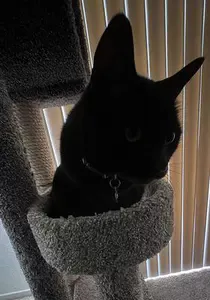Tips for Solving Cat Litter Box Problems
Solving cat litter box problems can be a challenge. Anything from an illness to stress can throw your cat off her routine.
Inappropriate elimination is said to be the number one reason that adult cats are brought shelters. I find this deeply disturbing.
I cannot stress enough that these problems can often be solved, and may involve a physical problem that you cannot detect.
Your veterinarian needs to be involved in the discussion, and physical problems ruled out before you approach the behavioral issues.
In the overview, we cover some of the major physical and behavioral causes of litter box avoidance. If you haven't read it, you might want to do that now.
You should be aware that even the most well adjusted cat can be thrown off by stress. Stress can come from many sources, including a change in household routine, the addition of a family member or pet, or the death of another pet. Even changing the amount of attention your cat receives can put stress on your cat.
Tips and Tricks for Resolving Cat Litter Box Problems
- Always have your cat checked by a vet as there could be an unseen health issue involved. No amount of behavioral retraining will work if this is the case, and it could be serious.
-
There are a host of medical problems that could be at fault, such as limited mobility in a sick or older cat, or a urinary tract infection, or constipation or bowel problem for example.
These problems will need to be addressed first before progress will be made. Some physical problems, such as mobility, may involve getting a different type of litter box as well. - Use the Whale Done approach. Don't scold your cat for doing what nature is forcing her to do, even if she's doing it where you don't want her to. Instead, praise her when she does what you want.
- Cats do not like loud noises, crowded spaces, and high traffic areas for "doing their business." Place the litter box in a quiet, always accessible, less frequently used area of the house.
- Follow the one plus one rule. Some cats just can't stand a box that was recently used. This is true even if they were the last (and only) cat to use it. One box for each cat in the house, plus one additional box.
- Clean the box often, and clean it well.
- Use unscented clumping litter. Many cats don't like the perfume in scented litters, still others don't like anything that doesn't feel like sand between the toes. Pellets, crystals, and wood chips don't feel like dirt, and your cat may not like it.
- Clean the area where your cat is pooping and peeing with Atmosklear or an enzymatic cleanser designed to remove urine and pet odor. Once a cat chooses an area to go in, they'll keep coming back and it's hard to break that cycle.
- Break the cycle by putting barriers up so your cat can't get to the "favorite wrong spot."
-
After thoroughly cleaning the bad area, put tin foil or double sided tape down on the floor to discourage your cat from walking there. Cats typically hate to walk on those materials.
You can try marking off most of the floor with tape or tinfoil and leave a path. Then put a litter box right there in the open path where your cat usually wants to make a mess. Or... feed your cat in that area. Cats won't normally go where they eat if they can help it. - Try a cage. Put your cat in a cage with a litter box. Feed her, and when she does her business in the box, let her out for a little while as a reward. Play with her and show her affection. Then put her back in.
If a physical problem was the cause of the behavior, then retraining may still need to take place once the medical issue is resolved. In any case, the retraining process may take weeks, and you must be consistent in order to help your cat modify her behavior. Again, cat litter box problems are often fixable, but you must be dedicated and patient with your kitty.
Litter Box Problems
Cat Lovers Only


Comments: What do you think?
Have your say about what you just read. Leave me a comment in the box below.